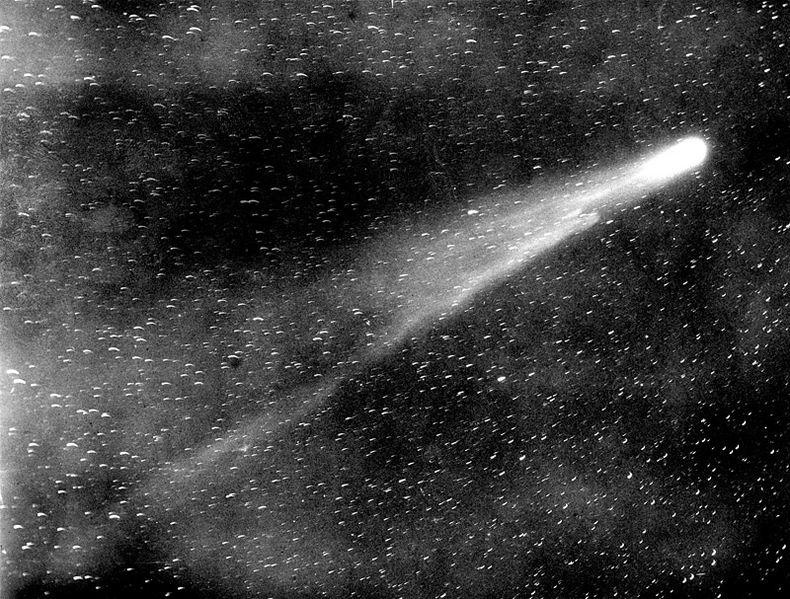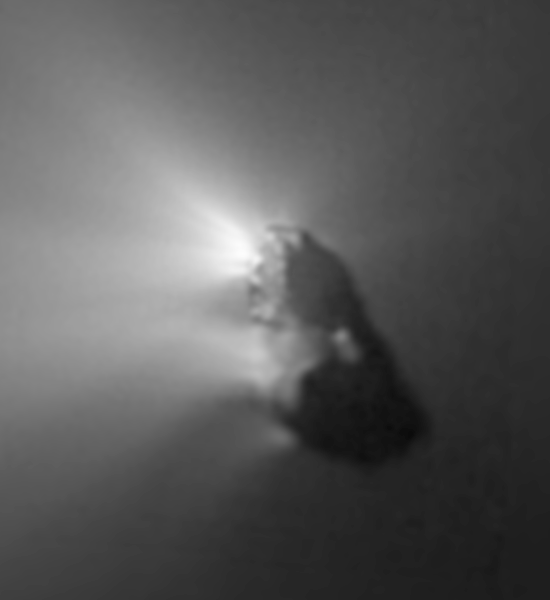
Comets
Comets are (traditionally) celestial bodies that
show comas and/or tails. A more modern definition is any planetoid composed
primarily of ices, which would boil off if the body was close enough to the Sun.
Comets near or beyond Jupiter's orbit are generally stable, as water ice is
unaffected by the Sun's warmth beyond about 5 au. Note that pure, clean, white
snow or ice is stable as far in as 2.7 au, in the middle of the Asteroid Belt,
but normal comets have significant quantities of dust and dark materials such as
hydrocarbons which increase the absorption of solar radiation.
Extinct Comets: Approximately 6% of observed asteroids are thought to be
extinct comets, having lost their ices (or at least the near-surface ones) due
to spending too much time in the inner solar system. Depending upon their
perihelion (distance of closest approach to the Sun), a comet can survive dozens
or even thousands of close approaches, but the total amount of elapsed time is
quite brief compared to the lifetime of the Solar System. Thus it is clear that
there must be a continual re-supply of fresh comets.
Short-period comets (those with orbital periods of less than 200 years)
typically orbit near the plane of the ecliptic, and have aphelion's (greatest
distance from the Sun) in the vicinity of the orbits of the outer planets.
Short-period comets are further divided into two main groups: Halley family
comets have orbits with periods from 20 to 200 years, and are thought to be
replenished from the Kuiper Belt by gravitational perturbations that bring them
close to an outer planet which then slingshots them back out or into the inner
solar system where they become visible as comets. Jupiter family comets
(with periods less than 20 years) may instead be replenished from the
populations of Jupiter's Lagrange Points, nudged out of their semi-stable orbits
by gravitational resonances. The Jupiter family comets also appear to have
greater lifetimes, on average, than the Halley family comets, as they typically
survive for a thousand or so orbits. This may be explained by their
proportionally lower water content, as long period comets appear to contain
approximately four times as much water ice. Note that the aphelia of
short-period comets tend to aggregate near the orbit of one of the giant
planets, and interactions with one of them is likely what sent the comet into
the inner solar system in the first place.
Long period comets have orbital periods greater than 200 years, and as
great as tens of thousands of years. Their orbits are highly eccentric, and
randomly oriented. Their aphelion's are in the vicinity of the scattered disk or
Oort Cloud, and the disturbance that sent them into the inner solar system may
be due to collisions, passages of other suns, or even the pull of the Milky Way.
It is not thought that these bodies originated in deep interstellar space, but
rather they were formed in the outer solar system along with the giant planets,
and their orbits were scattered into the scattered disk or Oort Cloud by
passages near those planets.
Single-apparition comets are somewhat mis-named, as they are equivalent
to long period comets but with extremely long periods, hundreds of thousands to
millions of years. These are still thought to be members of the solar system,
captives of the Sun's gravity. While passing through the inner Solar System
their orbits may appear to be parabolic or even slightly hyperbolic, but they
sill still have aphelia in the Oort Cloud.
 Historically,
comets were distinct from asteroids by the presence of a coma (meaning
hair) or tail, while asteroids (meaning starlike) were points. We now
know that the fuzzy appearance and the tails are due to outgassing, as the Sun's
warmth vaporizes water and other ices, which in turn carry dust and larger
particles away from the comet's nucleus. This forms a huge cloud (still nearly a
vacuum) around the core of the comet, giving it a fuzzy appearance. Interaction
with the solar wind blows the dust and gasses into one or more tails. Historically,
comets were distinct from asteroids by the presence of a coma (meaning
hair) or tail, while asteroids (meaning starlike) were points. We now
know that the fuzzy appearance and the tails are due to outgassing, as the Sun's
warmth vaporizes water and other ices, which in turn carry dust and larger
particles away from the comet's nucleus. This forms a huge cloud (still nearly a
vacuum) around the core of the comet, giving it a fuzzy appearance. Interaction
with the solar wind blows the dust and gasses into one or more tails.
Comets may have multiple tails. The gas tail is illuminated by
photo-ionization, and points directly away from the Sun (blown by the solar
wind).
The dust tail consists of more massive particles (even if still minute)
which tend to follow the comet's orbit around the sun as modified by the jets of
their birth and the pressure of the solar wind, magnetic forces, thermal and
photonic effects, and of other jets. There can be multiple dust tails, each
formed by different outgassing jets from the comet's nucleus, or due to
different particle masses (fine dust, for example, is more strongly affected by
the solar wind than are sand-size grains). Tails frequently change appearance as
the nucleus rotates, exposing different parts of its surface to the heat of the
Sun, and as individual jets are born and die.
The meteor showers that repeat every year are due to the Earth's orbit
passing through the orbital path of a comet (possibly extinct). How close the
Earth passes to the center of the orbit, and how close to the path of the comet
itself, affects the strength of the shower.
While the defining constituent of a comet may be ice (and primarily water ice),
they are far from pure, and will generally contain materials from many areas of
the original solar nebula, including refractory
minerals formed near the Sun, probably
chondrules, and certainly presolar grains.
When they are not actively outgassing, comets are extremely dark, more so than
charcoal. It seems likely that the outer crust of most comets consists of a
crust of dust and dark organic matter, left over as the ices sublimated, a crust
which grows thicker with every passage by the Sun until the comet ceases to
vaporize and goes extinct.
|